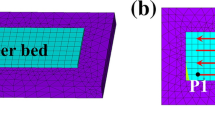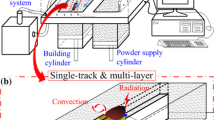Abstract
It is well known that high thermal stresses in the formed parts during selective laser melting (SLM) heavily affect the part quality and performance. In this study, the mechanism of thermal stress formation due to temperature gradients in SLM of 316L stainless steel is investigated. The uniqueness of this study lies in the fact that a realistic multi-track and multi-layer SLM process is modeled and simulated that adopts the identical conditions of the actual part building on a commercial SLM system, and the final residual stresses are compared between the simulation and the experimental measurements on the actual parts. The results indicate that both temperature and stress evolution of material points exhibit cyclic patterns during the SLM process, and the changes with regard to time are dramatic thanks to the rapid heating and cooling of localized areas. However, the rapid temperature decrease is actually accompanied by stress increase in the material points, and vice versa. Under the laser power of 160 W and scanning speed of 500 mm/s, a melting pool is formed and rapidly expanded to the adjacent pre-solidified layer, and the diffusion depth is about 200 μm. Also, unlike the overall attenuation of temperature as the SLM build process progresses, the magnitude of stress oscillation actually increases. Furthermore, during the rapid solidification, the core of melting pool is subject to tensile stress. The tensile stress could be partially mitigated by the laser heating of subsequent layers, but it cannot be completely removed. As a result, the accumulation effect of multiple layers leads to significant tensile stress, in particular, in the bottom layers that are closer to the base plate. The effective stress in the bottom layer attached to the base plate reaches as high as 680 MPa based on the settings of SLM process. Finally, the experiment measurement on residual stress overall agrees with the simulation results. Both show that the residual stress ranges from 100 to 350 MPa for the layers 1.4 mm above the base plate, and that the tensile stress tends to increase along the direction towards the base plate.
















Similar content being viewed by others
References
Marya M, Singh V, Marya S, Hascoet JY (2015) Microstructural development and technical challenges in laser additive manufacturing: case study with a 316L industrial part. Metall Mater Trans B 46(4):1654–1665
Kim WJ, Nguyen HH, Kim HY, Nguyen MT, Park HS, Kim JC (2017) Sintering and microstructures of SUS 316L powder produced by 3D printing process. Arch Metall Mater 62(2):1215–1218
Ren X, Shao H, Lin T, Zheng H (2016) 3D gel-printing—an additive manufacturing method for producing complex shape parts. Mater Des 101:80–87
Kamath C, El-Dasher B, Gallegos GF, King WE, Sisto A (2014) Density of additively-manufactured, 316l ss parts using laser powder-bed fusion at powers up to 400 w. Int J Adv Manuf Technol 74(1-4):65–78
Attar H, Calin M, Zhang LC, Scudino S, Eckert J (2014) Manufacture by selective laser melting and mechanical behavior of commercially pure titanium. Mater Sci Eng A 593(2):170–177
Guan K, Wang Z, Gao M, Li X, Zeng X (2013) Effects of processing parameters on tensile properties of selective laser melted 304 stainless steel. Mater Des 50(17):581–586
Stoll P, Spierings A, Wegener K (2019) Impact of a process interruption on tensile properties of SS 316L parts and hybrid parts produced with selective laser melting. Int J Adv Manuf Technol:1–10
Sing SL, Yeong WY, Wiria FE, Tay BY (2016) Characterization of titanium lattice structures fabricated by selective laser melting using an adapted compressive test method. Exp Mech 56(5):735–748
Pace ML, Guarnaccio A, Dolce P, Mollica D, Parisi GP, Lettino A, Medici L, Summa V, Ciancio R, Santagata A (2017) 3d additive manufactured 316l components microstructural features and changes induced by working life cycles. Appl Surf Sci 418:437–445
Aboulkhair NT, Maskery I, Tuck C, Ashcroft I, Everitt NM (2016) Improving the fatigue behaviour of a selectively laser melted aluminium alloy: influence of heat treatment and surface quality. Mater Des 104:174–182
Fotovvati B, Namdari N, Dehghanghadikolaei A (2018) Fatigue performance of selective laser melted Ti6Al4V components: state of the art. Mater Res Express 6(1):012002
Feng Q, Tang Q, Liu Y, Setchi R, Soe S, Ma S, Bai L (2018) Quasi-static analysis of mechanical properties of Ti6Al4V lattice structures manufactured using selective laser melting. Int J Adv Manuf Technol 94(5-8):2301–2313
Wang L, Felicelli S, Gooroochurn Y, Wang PT, Horstemeyer MF (2008) Optimization of the LENS ® process for steady molten pool size. Mater Sci Eng A 474(1):148–156
Khairallah SA, Anderson A (2014) Mesoscopic simulation model of selective laser melting of stainless steel powder. J Mater Process Technol 214(11):2627–2636
Foroozmehr A, Badrossamay M, Foroozmehr E, Golabi S (2016) Finite element simulation of selective laser melting process considering optical penetration depth of laser in powder bed. Mater Des 89:255–263
Khairallah SA, Anderson AT, Rubenchik A, King WE (2016) Laser powder-bed fusion additive manufacturing: physics of complex melt flow and formation mechanisms of pores, spatter, and denudation zones. Acta Mater 108:36–45
Huang Y, Yang LJ, Du XZ, Yang YP (2016) Finite element analysis of thermal behavior of metal powder during selective laser melting. Int J Therm Sci 104:146–157
Debroy T, Zhang W, Turner J, Babu SS (2016) Building digital twins of 3d printing machines. Scr Mater 135:119–124
Zavala-Arredondo M, Ali H, Groom KM, Mumtaz K (2018) Investigating the melt pool properties and thermal effects of multi-laser diode area melting. Int J Adv Manuf Technol 97:1383–1396
Fotovvati B, Wayne SF, Lewis G, Asadi E (2018) A review on melt-pool characteristics in laser welding of metals. Adv Mater Sci Eng 2018:1–18
Paul R, Anand S, Gerner F (2014) Effect of thermal deformation on part errors in metal powder based additive manufacturing processes. J Manuf Sci Eng 136(3):031009
Yadroitsev I, Yadroitsava I (2015) Evaluation of residual stress in stainless steel 316 l and Ti6Al4V samples produced by selective laser melting. Virtual Phys Prototy 10(2):67–76
Sochalski-Kolbus LM, Payzant EA, Cornwell PA, Watkins TR, Babu SS, Dehoff RR, Lorenz M, Ovchinnikova O, Duty C (2015) Comparison of residual stresses in Inconel 718 simple parts made by electron beam melting and direct laser metal sintering. Metall Mater Trans A 46(3):1419–1432
Denlinger ER, Heigel JC, Pan M, Palmer TA (2015) Effect of inter-layer dwell time on distortion and residual stress in additive manufacturing of titanium and nickel alloys. J Mater Process Technol 215:123–131
Mishurova T, Cabeza S, Artzt K, Haubrich J, Klaus M, Genzel C, Requena G, Bruno G (2017) An assessment of subsurface residual stress analysis in SLM Ti-6Al-4V. Materials 10(4):348
Vora P, Mumtaz K, Todd I, Hopkinson N (2015) AlSi12 in-situ alloy formation and residual stress reduction using anchorless selective laser melting. Addit Manuf 7:12–19
Oladijo OP, Venter AM, Cornish LA, Sacks N (2012) X-ray diffraction measurement of residual stress in WC-Co thermally sprayed coatings onto metal substrates. Surf Coat Technol 206(23):4725–4729
Yan JJ, Zheng DL, Li HX, Jia X, Sun JF, Li YL, Qian M, Yan M (2017) Selective laser melting of H13: microstructure and residual stress. J Mater Sci 52(20):12476–12485
Brown DW, Bernardin JD, Carpenter JS, Clausen B, Spernjak D, Thompson JM (2016) Neutron diffraction measurements of residual stress in additively manufactured stainless steel. Mater Sci Eng A 678:291–298
Wang Z, Denlinger E, Michaleris P, Stoica AD, Ma D, Beese AM (2017) Residual stress mapping in Inconel 625 fabricated through additive manufacturing: method for neutron diffraction measurements to validate thermomechanical model predictions. Mater Des 113:169–177
An K, Yuan L, Dial L, Spinelli I, Stoica AD, Gao Y et al (2017) Neutron residual stress measurement and numerical modeling in a curved thin-walled structure by laser powder bed fusion additive manufacturing. Mater Des 135:122–132
Jahed H, Faritus MR, Jahed Z (2012) Residual stress measurements in an autofrettage tube using hole drilling method. J Press Vessel Technol Trans ASME 134(5):051501
Osten, W., & Pedrini, G. (2015). A flexible method for residual stress measurement of spray coated layers by laser made hole drilling and SLM based beam steering. SPECKLE 2015: VI International Conference on Speckle Metrology (Vol. 9660). International Society for Optics and Photonics
Liu F, Lin X, Yang G, Song M, Chen J, Huang W (2011) Microstructure and residual stress of laser rapid formed Inconel 718 nickel-base superalloy. Opt Laser Technol 43(1):208–213
Song B, Dong S, Liu Q, Liao H, Coddet C (2014) Vacuum heat treatment of iron parts produced by selective laser melting: microstructure, residual stress and tensile behavior. Mater Des 54(2):727–733
Lu Y, Wu S, Gan Y, Huang T, Yang C, Lin J et al (2015) Study on the microstructure, mechanical property and residual stress of SLM Inconel-718 alloy manufactured by differing island scanning strategy. Opt Laser Technol 75:197–206
Krol TA, Seidel C, Zaeh MF (2013) Prioritization of process parameters for an efficient optimisation of additive manufacturing by means of a finite element method. Procedia CIRP 12:169–174
Hussein A, Hao L, Yan C, Everson R (2013) Finite element simulation of the temperature and stress fields in single layers built without-support in selective laser melting. Mater Des 52(24):638–647
Zohdi TI (2015) Modeling and simulation of cooling-induced residual stresses in heated particulate mixture depositions in additive manufacturing. Comput Mech 56(4):613–630
Parry L, Ashcroft IA, Wildman RD (2016) Understanding the effect of laser scan strategy on residual stress in selective laser melting through thermo-mechanical simulation. Addit Manuf 12:1–15
Liu Y, Yang Y, Wang D (2016) A study on the residual stress during selective laser melting (slm) of metallic powder. Int J Adv Manuf Technol 87(1-4):1–10
Yang Q, Zhang P, Cheng L, Min Z, Chyu M, To AC (2016) Finite element modeling and validation of thermomechanical behavior of Ti-6Al-4V in directed energy deposition additive manufacturing. Addit Manuf 12:169–177
Zaeh MF, Branner G (2010) Investigations on residual stresses and deformations in selective laser melting. Prod Eng 4(1):35–45
Vastola G, Zhang G, Pei QX, Zhang YW (2016) Controlling of residual stress in additive manufacturing of Ti6Al4V by finite element modeling. Addit Manuf 12:231–239
Criales LE, Arısoy YM, Özel T (2016) Sensitivity analysis of material and process parameters in finite element modeling of selective laser melting of Inconel 625. Int J Adv Manuf Technol 86(9-12):2653–2666
Gu D, He B (2016) Finite element simulation and experimental investigation of residual stresses in selective laser melted Ti–Ni shape memory alloy. Comput Mater Sci 117(6):221–232
Zhao X, Iyer A, Promoppatum P, Yao SC (2017) Numerical modeling of the thermal behavior and residual stress in the direct metal laser sintering process of titanium alloy products. Addit Manuf 14:126–136
Mercelis P, Kruth J (2006) Residual stresses in selective laser sintering and selective laser melting. Rapid Prototyp J 12(5):254–265
Li Y, Zhou K, Tan P, Shu BT, Chua CK, Leong KF (2018) Modeling temperature and residual stress fields in selective laser melting. Int J Mech Sci 136:24–35
Ali H, Ghadbeigi H, Mumtaz K (2018) Residual stress development in selective laser-melted ti6al4v: a parametric thermal modelling approach. Int J Adv Manuf Technol 97(5-8):2621–2633
Carslow HS, Jaeger JC, Morral JE (1992) Conduction of heat in solids, second edition. J Eng Mater Technol 108(4):378
Zhong Y, Liu L, Wikman S, Cui D, Shen Z (2016) Intragranular cellular segregation network structure strengthening 316 l stainless steel prepared by selective laser melting. J Nucl Mater 470:170–178
Jiang C, Yang C (2013) Internal stress diffraction analysis. Science Publishing Company, Beijing
Acknowledgments
The first author would like to acknowledge the following project support, (1) Key Research Project of Shaanxi Provincial Department of Education (No. 18JS097), (2) Shaanxi Key Laboratory of Surface Engineering and Remanufacturing Tianyuan Fund (No. tywl2019-07), and (3) Xi’an Science and Technology Innovation Plan (No. 201805066ZD17CG50).
Author information
Authors and Affiliations
Corresponding author
Additional information
Publisher’s note
Springer Nature remains neutral with regard to jurisdictional claims in published maps and institutional affiliations.
Rights and permissions
About this article
Cite this article
Bian, P., Shi, J., Shao, X. et al. Evolution of cyclic thermal stress in selective laser melting of 316L stainless steel: a realistic numerical study with experimental verification. Int J Adv Manuf Technol 104, 3867–3882 (2019). https://doi.org/10.1007/s00170-019-04096-0
Received:
Accepted:
Published:
Issue Date:
DOI: https://doi.org/10.1007/s00170-019-04096-0




